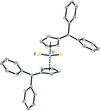issue contents
April 2018 issue

Cover illustration: Seven new 1,4-diaryl-5-trifluoromethyl-1H-1,2,3-triazoles have been synthesized and their X-ray structures determined and compared to that of J147, a recently reported promising new drug for the treatment of Alzheimer's disease. B3LYP/6-311++G(d,p) calculations have been performed to determine the potential surface and the molecular electrostatic potential (MEP) of J147, and to examine the correlation between hydrazone J147 and the 1,2,3-triazoles. See Farrán, Bonet, Claramunt, Torralba, Alkorta & Elguero [Acta Cryst. (2018), C74, 513-522].
research papers










 access
access





















 journal menu
journal menu
































